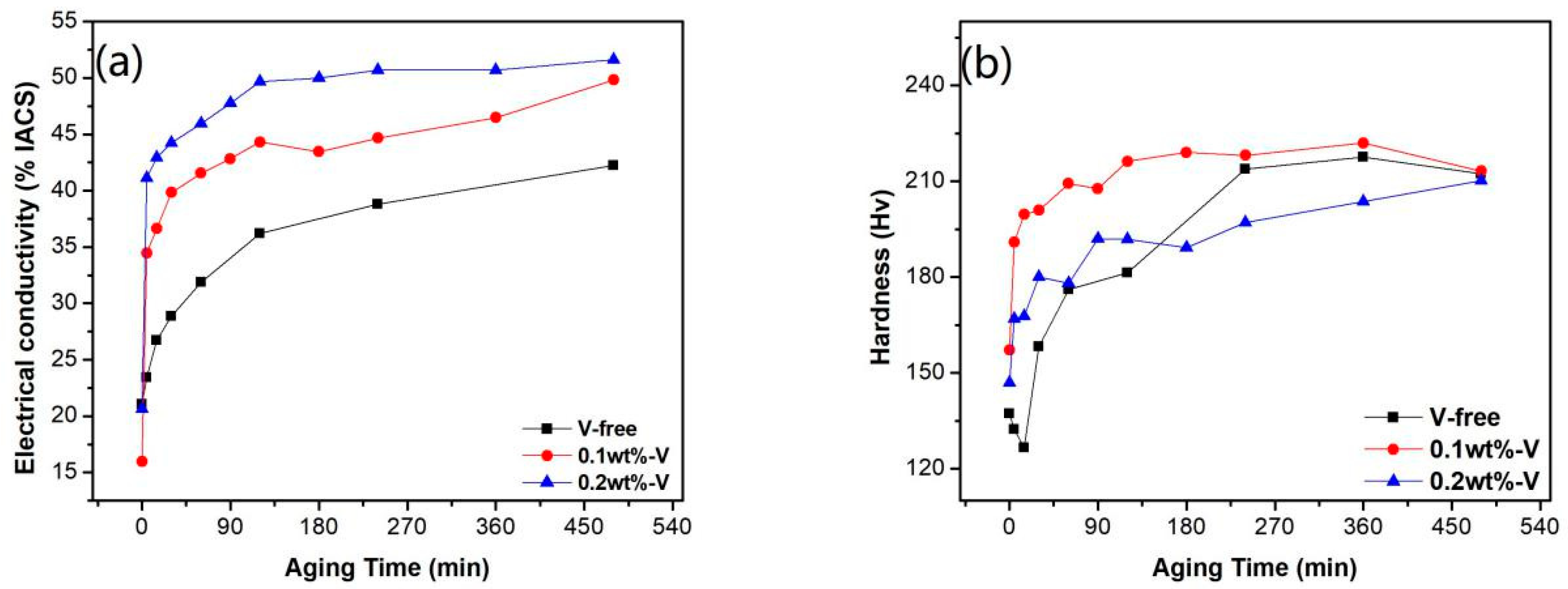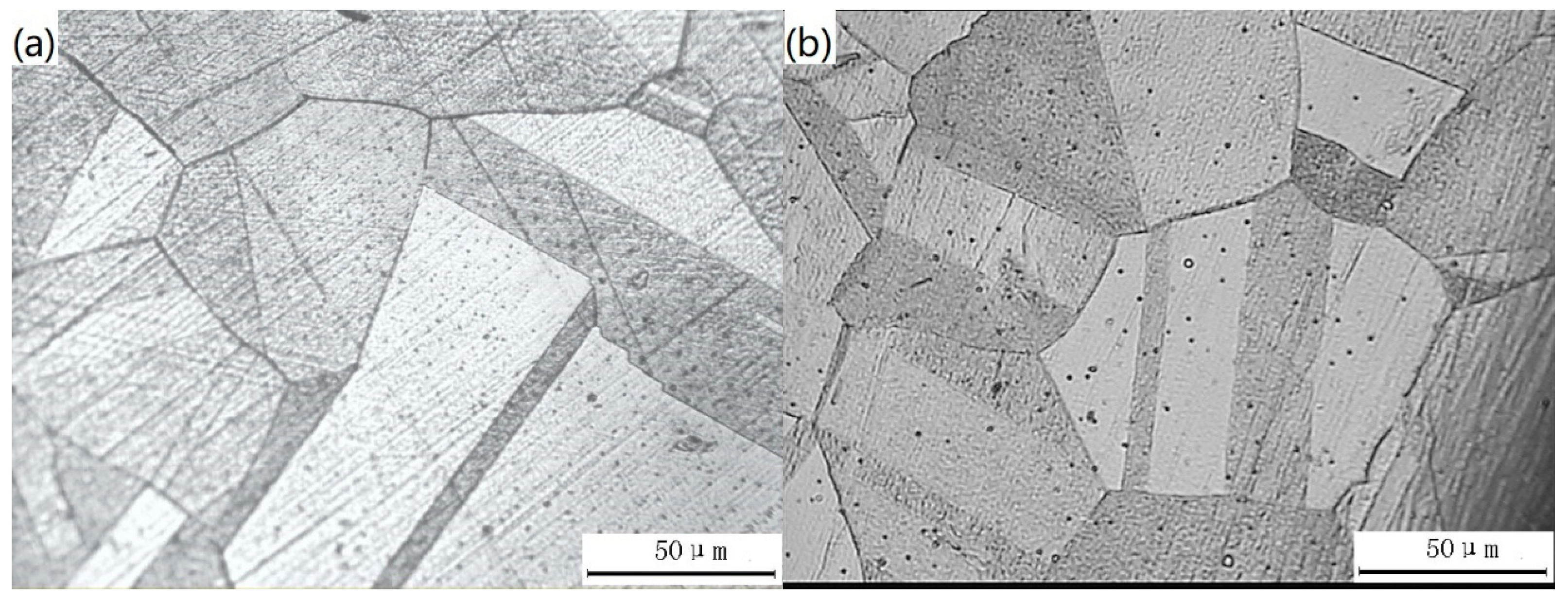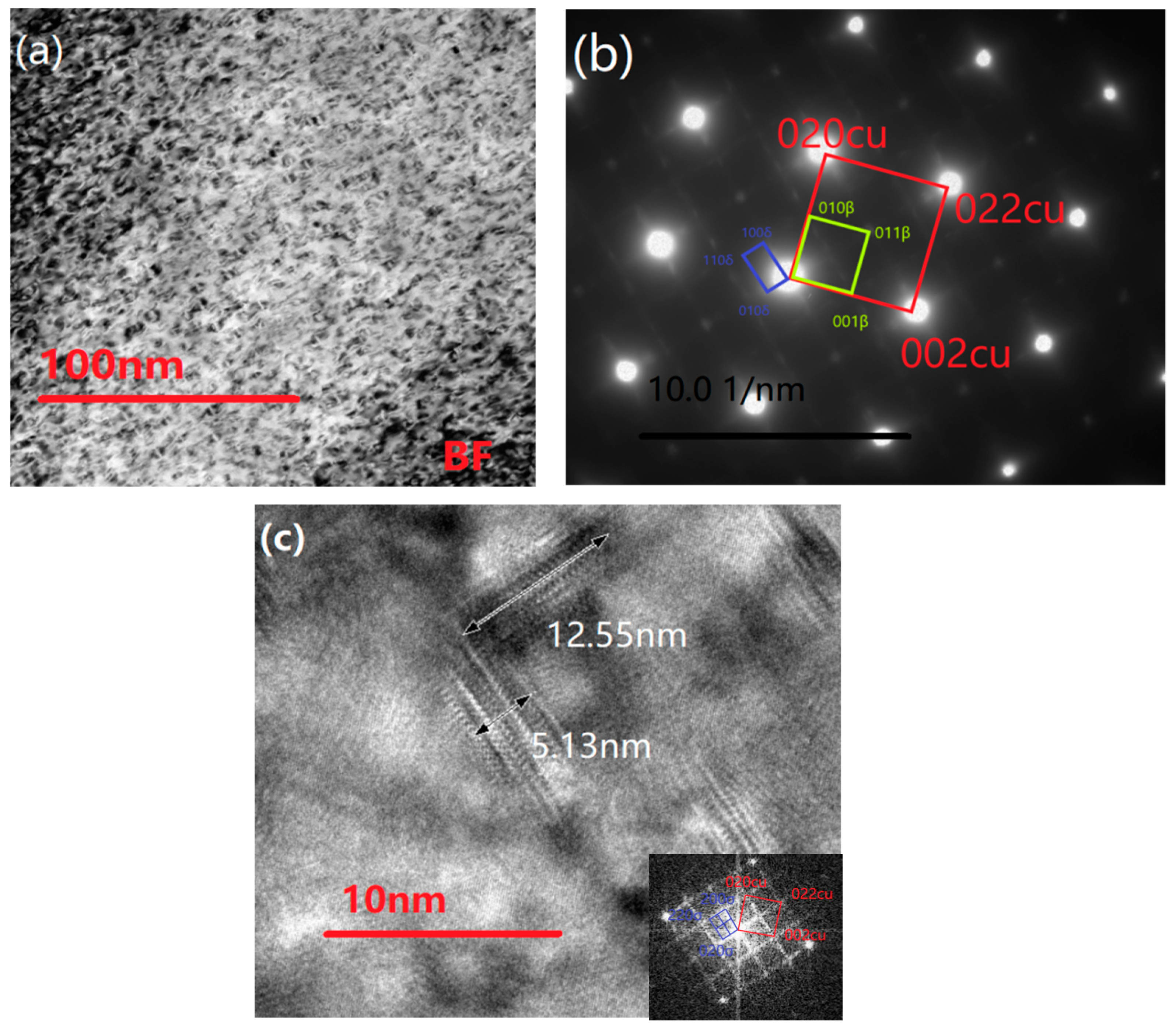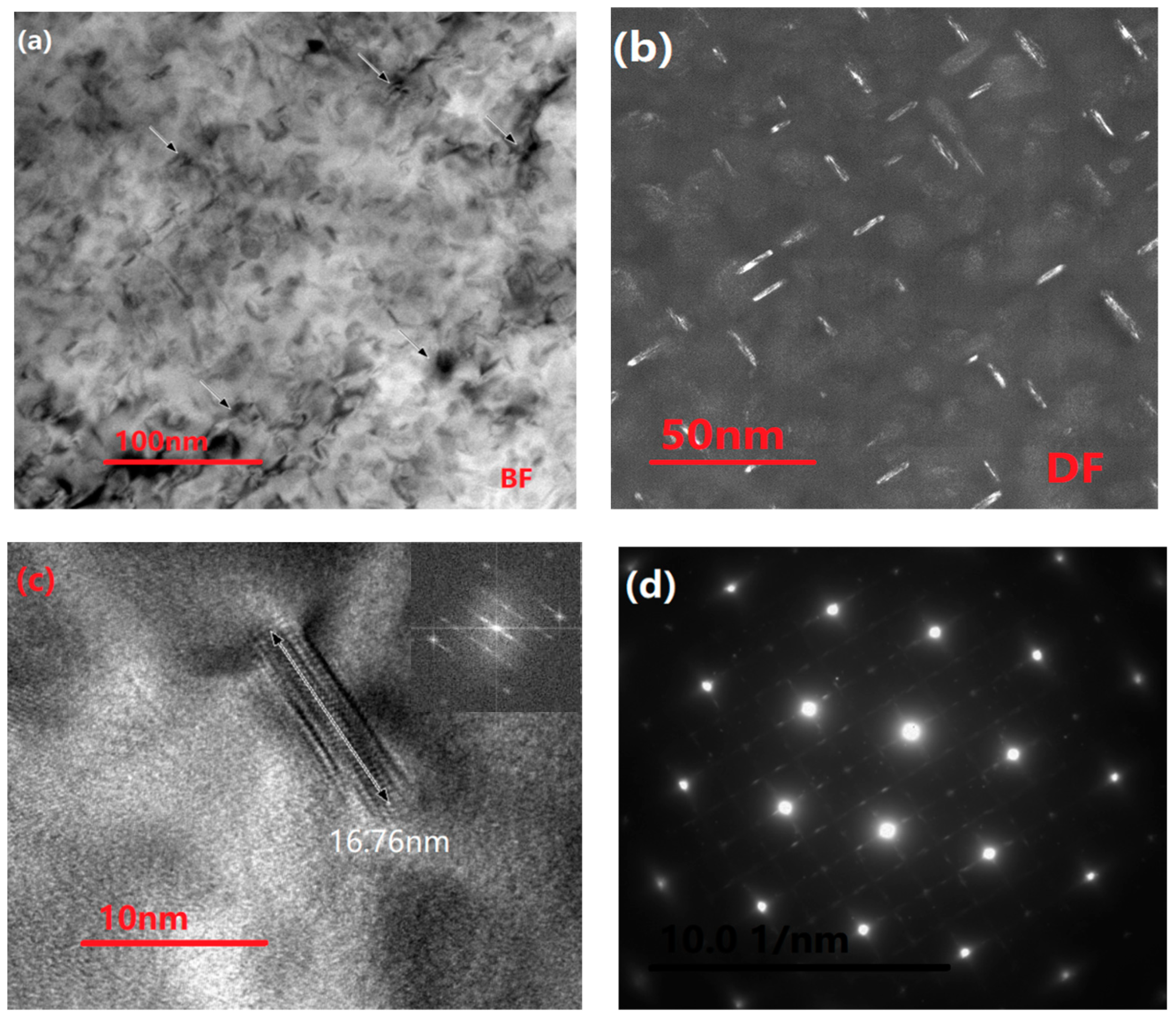Effect of V Addition on Microstructure and Properties of Cu-1.6Ni-1.2Co-0.65Si Alloys
Abstract
:1. Introduction
2. Materials and Methods
3. Results
3.1. Electrical Conductivity and Hardness
3.2. Mechanical Properties
3.3. Microstructure of Samples Treated by Solution Treatment (Process 1)
4. Discussion
4.1. Electrical Conductivity
4.2. Property Comparison
4.3. Mechanical Properties
4.3.1. Precipitation Strengthening
4.3.2. Grain Boundary Strengthening
4.4. Hardness
5. Conclusions
Author Contributions
Funding
Conflicts of Interest
References
- Huang, F.; Ma, J.; Ning, H.; Cao, Y.W.; Geng, Z.T. Precipitation in Cu-Ni-Si-Zn alloy for lead frame. Mater. Lett. 2003, 57, 2135–2139. [Google Scholar] [CrossRef]
- Sun, W.H.; Xu, H.H.; Liu, S.H.; Du, Y.; Yuan, Z.H.; Huang, B.Y. Phase equilibria of the Cu-Ni-Si system at 700 °C. J. Alloy. Compd. 2011, 509, 9776–9781. [Google Scholar] [CrossRef]
- Ryoichi, M.; Chihiro, W. Microstructure and mechanical properties of Cu-Ni-Si alloys. Mater. Sci. Eng. A 2008, 483–484, 117–119. [Google Scholar]
- Cao, Y.; Ma, J.; Tang, X.; Wang, B.; Wang, S.; Li, H. Design of Cu-Ni-Si copper alloy for lead Frame. Chin. J. Nonferrous Metals 1999, 9, 723–727. [Google Scholar]
- Zhang, Z.J.; Zhang, P.; Zhang, Z.F. Cyclic softening behaviors of ultra-fine grained Cu-Zn alloys. Acta Mater. 2016, 121, 331–342. [Google Scholar] [CrossRef]
- Zhang, Z.J.; Pang, J.C.; Zhang, Z.F. Optimizing the fatigue strength of ultrafine grained Cu-Zn alloys. Mater. Sci. Eng. A 2016, 666, 305–313. [Google Scholar] [CrossRef]
- Lu, K.; Lu, L.; Suresh, S. Strengthening materials by engineering coherent internal boundaries at the nanoscale. Science 2009, 324, 349–352. [Google Scholar] [CrossRef] [PubMed]
- Shakib Hamedan, S.; Abdi, M.; Sheibani, S. Comparative study on hot rolling of Cu-Cr and Cu-Cr-CNT nanocomposites. Trans. Nonferrous Met. Soc. China 2018, 28, 2044–2052. [Google Scholar] [CrossRef]
- Luo, B.M.; Li, D.X.; Zhao, C.; Wang, Z.; Luo, Z.Q.; Zhang, W.W. A low Sn content Cu-Ni-Sn alloy with high strength and good ductility. Mater. Sci. Eng. A 2019, 746, 154–161. [Google Scholar] [CrossRef]
- Lei, Q.; Xian, Z.; Hu, W.P.; Derby, B.; Li, Z. Phase transformation behaviors and properties of a high strength Cu-Ni-Si alloy. Mater. Sci. Eng. A 2017, 697, 37–47. [Google Scholar] [CrossRef]
- Soffa, W.A.; Laughlin, D.E. High-strength age hardening copper-titanium alloys: Redivivus. Prog. Mater. Sci. 2004, 49, 347–366. [Google Scholar] [CrossRef]
- Xie, H.; Jia, L.; Lu, Z.L. Microstructure and solidification behavior of Cu-Ni-Si alloys. Mater. Charact. 2009, 60, 114–118. [Google Scholar] [CrossRef]
- Suzuk, S.; Shibutani, N.; Mimura, K.; Isshiki, M.; Waseda, Y. Improvement in strength and electrical conductivity of Cu-Ni-Si alloys by aging and cold rolling. J. Alloy. Compd. 2006, 417, 116–120. [Google Scholar] [CrossRef]
- Lee, E.; Han, S.; Euh, K.; Lim, S.; Kim, S. Effect of Ti Addition on Tensile Properties of Cu-Ni-Si Alloys. Met. Mater. Int. 2011, 17, 569–576. [Google Scholar] [CrossRef]
- Lei, Q.; Li, Z.; Dai, C.; Wang, J.; Chen, X.; Xie, J.M.; Yang, W.W.; Chen, D.L. Effect of aluminum on microstructure and property of Cu–Ni–Si alloys. Mater. Sci. Eng. A 2013, 572, 65–74. [Google Scholar] [CrossRef]
- Zhang, Y.; Liu, P.; Tian, B.H.; Liu, Y.; Li, R.Q.; Xu, Q.Q. Hot deformation behavior and processing map of Cu-Ni-Si-P alloy. Trans. Mater. Heat Treat. 2013, 23, 2341–2347. [Google Scholar] [CrossRef]
- Wu, Y.K.; Li, Y.; Lu, J.Y.; Tan, S.; Jiang, F.; Sun, J. Correlations between microstructures and properties of Cu-Ni-Si-Cr alloy. Mater. Sci. Eng. A 2018, 731, 403–412. [Google Scholar] [CrossRef]
- Wang, W.; Kang, H.J.; Chen, Z.N.; Chen, Z.J.; Zou, C.L.; Li, R.G.; Yin, G.M.; Wang, T.M. Effects of Cr and Zr additions on microstructure and properties of Cu-Ni-Si alloys. Mater. Sci. Eng. A 2016, 673, 378–390. [Google Scholar] [CrossRef]
- Xiao, X.P.; Yi, Z.Y.; Chen, T.T.; Liu, R.Q.; Wang, H. Suppressing spinodal decomposition by adding Co into Cu-Ni-Si alloy. J. Alloy. Compd. 2016, 660, 178–183. [Google Scholar] [CrossRef]
- Ozawa, A.; Watanabe, C.; Monzen, R. Influence of Co on Strength of Cu-Ni-Co-Si Alloy. Mater. Sci. 2014, 783–786, 2468–2473. [Google Scholar] [CrossRef]
- Sugawara, A.; Gao, W.; Suzuki, M.; Robinson. Development of high strength copper alloy (C7035) for Microminiature Connectors. Bull. Inst. Met. 2012, 51, 73–75. [Google Scholar]
- Han, S.Z.; Gu, J.H.; Lee, J.H.; Que, Z.P.; Shin, J.H.; Lim, S.H.; Kim, S.S. Effect of V Addition on Hardness and Electrical Conductivity in Cu-Ni-Si Alloys. Met. Mater. Int. 2013, 19, 637–641. [Google Scholar] [CrossRef]
- Wei, H.; Chen, Y.L.; Su, L.; Tang, D.; Xu, Z.J. Study on Texture Evolution and Deformation Mechanism of the Cu-Ni-Si Alloy during Cold-rolling Treatment. Procedia Eng. 2017, 207, 1111–1116. [Google Scholar] [CrossRef]
- Yang, B.; Wu, M.Z.; Li, X.; Zhang, J.W.; Wang, H.Q. Effects of cold working and corrosion on fatigue properties and fracture behaviors of precipitate strengthened Cu-Ni-Si alloy. Int. J. Fatigue 2018, 116, 118–127. [Google Scholar] [CrossRef]
- Wu, Y.K.; Li, Y.; Lu, J.Y.; Tan, S.; Jiang, F.; Sun, J. Effects of pre-deformation on precipitation behaviors and properties in Cu-Ni-Si-Cr alloy. Mater. Sci. Eng. A 2019, 742, 501–507. [Google Scholar] [CrossRef]
- Li, R.G.; Guo, E.Y.; Chen, Z.N.; Kang, H.J.; Wang, W.; Zou, C.L.; Li, T.J.; Wang, T.M. Optimization of the balance between high strength and high electrical conductivity in CuCrZr alloys through two-step cryorolling and aging. J. Alloy. Compd. 2019, 771, 1044–1051. [Google Scholar] [CrossRef]
- Huang, J.Z.; Xiao, Z.; Dai, J.; Li, Z.; Jiang, H.Y.; Wang, W.; Zhang, X.X. Microstructure and Properties of a Novel Cu-Ni-Co-Si-Mg Alloy with Super-high Strength and Conductivity. Mater. Sci. Eng. A 2019, 744, 754–763. [Google Scholar] [CrossRef]
- Wang, Q.S.; Xie, G.L.; Mi, X.J.; Xiong, B.Q.; Xiao, X.P. The Precipitation and Strengthening Mechanism of Cu-Ni-Si-Co Alloy. Mater. Sci. Forum. 2013, 749, 294–298. [Google Scholar] [CrossRef]
- Petrova, L.G.; Chudina, O.V. Comparison of dispersion hardening by coherent and incoherent nitrides in nitriding of alloys based on iron, nickel, and cobalt. Mater. Heat Treat. 2000, 42, 183–188. [Google Scholar] [CrossRef]
- Lengeler, B.; Schilling, W.; Wenzl, H. Deviations from Matthiessen’s rule and longitudinal magnetoresistance in cold-worked and neutron-irradiated copper. J. Low Temp. Phys. 1970, 2, 237–254. [Google Scholar] [CrossRef]
- Morris, M.A.; Leboeuf, M. Recrystallization mechanisms in a CuCrZr alloy with a bimodal distribution of particles. Mater. Sci. Eng. A 1994, 188, 255–265. [Google Scholar] [CrossRef]
- Huang, A.H.; Wang, Y.F.; Wang, M.S.; Song, L.Y.; Li, Y.S.; Gao, L.; Huang, C.X.; Zhu, Y.T. Optimizing the strength, ductility and electrical conductivity of a Cu-Cr-Zr alloy by rotary swaging and aging treatment. Mater. Sci. Eng. A 2019, 746, 211–216. [Google Scholar] [CrossRef]
- Djurić, B.; Jovanović, M.; Drobnjak, D. A study of precipitation in Cu-Be alloys. Metallography 1980, 13, 235–247. [Google Scholar] [CrossRef]
- Sakai, T. Misfit strains of precipitated phases and dimensional changes in Cu-Be alloys. Philos. Mag. 2008, 88, 1401–1410. [Google Scholar]
- Watanabe, C.; Takeshita, S.; Monzen, R. Effects of small addition of Ti on strength and microstructure of a Cu-Ni-Si alloy. Metall. Mater. Trans. A 2015, 46, 2469–2475. [Google Scholar] [CrossRef]
- Qian, S.N.; Li, D.M.; Wang, Q.; Dong, C.; Chen, B.; Hou, D.F. Composition optimization of high-strength and conductive Cu-Ti alloys using a cluster-formula approach. Trans. Mater. Heat Treat. 2016, 37, 7–11. [Google Scholar]
- Jeon, W.S.; Shur, C.C.; Kim, J.G.; Han, S.Z.; Kim, Y.S. Effect of Cr on the corrosion resistance of Cu-6Ni-4Sn alloys. J. Alloy. Compd. 2008, 455, 358–363. [Google Scholar] [CrossRef]
- Watwe, A.S.; Kelley, H.E. Composite Materials Comprising a Hard Ceramic Phase and a Cu–Ni–Sn Alloy. US Patent US8349466B2, 8 January 2013. [Google Scholar]
- Zhou, X.Z.; Su, Y.C. A novel Cu-Ni-Zn-Al alloy with high strength through precipitation hardening. Mater. Sci. Eng. A 2010, 527, 5153–5156. [Google Scholar] [CrossRef]
- Lei, Q.; Li, Z.; Xiao, T.; Pang, Y.; Xiang, Z.Q.; Qiu, W.T.; Xiao, Z. A new ultrahigh strength Cu-Ni-Si alloy. Intermetallics 2013, 42, 77–84. [Google Scholar] [CrossRef]
- Martin, J.W. Micromechanism in Particle-Hardened Alloys; Cambridge University Press: Cambridge, UK, 1984; p. 44. [Google Scholar]
- Liu, W.H.; Wu, Y.; He, J.Y. Grain growth and the Hall-Petch relationship in a high-entropy FeCrNiCoMn alloy. Scr. Mater. 2013, 68, 526–529. [Google Scholar] [CrossRef]











| Treatment | Process | Treatment Process |
|---|---|---|
| Solution treatment | Process 1 | Homogenizing at 850 °C for 10 min and cold rolling into 1.56 mm and solution treatment at 950 °C for 10min and then aging at 500 °C from 0 to 480 min. |
| Cold rolling treatment | Process 2 | Solution treatment at 950 °C for 30 min and cold rolling into 1.40 mm and aging at 500 °C from 0 to 480 min. |
| Two-step aging treatment | Process 3 | Solution treatment at 950 °C for 30 min and pre-aging at 500 °C for 2 h and cold rolling into 1.60 mm; and aging at 350 °C from 0 to 9 h (final aging) |
| Specimen Designation | Content (wt.%) | ||||
|---|---|---|---|---|---|
| V | Ni | Co | Si | Cu | |
| Cu-Ni-Co-Si | - | 1.60 | 1.19 | 0.65 | Balance |
| Cu-Ni-Co-Si-0.1V | 0.10 | 1.60 | 1.20 | 0.65 | Balance |
| Cu-Ni-Co-Si-0.2V | 0.21 | 1.60 | 1.18 | 0.65 | Balance |
| Process | Addition (wt.%) | Time (min) | Electrical Conductivity (%IACS) | Hardness (Hv) | Yield Strength (MPa) | Elongation (%) | Tensile Strength (MPa) |
|---|---|---|---|---|---|---|---|
| 1 | 0.1 | 240 | 44.66 | 218.15 | 533.15 | 6.0 | 687.69 |
| 1 | 0.1 | 360 | 46.47 | 222.00 | 547.23 | 5.6 | 687.31 |
| 1 | 0.2 | 360 | 50.69 | 203.64 | 536.23 | 9.8 | 711.59 |
| 1 | 0.2 | 480 | 51.64 | 210.15 | 565.37 | 9.4 | 726.52 |
| 2 | 0.1 | 240 | 38.45 | 288.45 | 684.83 | 4.2 | 752.18 |
| 2 | 0.1 | 480 | 46.12 | 293.88 | 721.76 | 6.5 | 782.20 |
| 2 | 0.2 | 180 | 44.40 | 252.52 | 672.60 | 3.3 | 733.80 |
| 2 | 0.2 | 240 | 43.36 | 253.88 | 720.57 | 8.1 | 769.05 |
| Process | Cu-Ni-Co-Si | Cu-Ni-Co-Si-0.1V | Cu-Ni-Co-Si-0.2V |
|---|---|---|---|
| Solution treatment | 23.45 | 34.48 | 41.12 |
| Cold rolling | 21.38 | 22.07 | 35.26 |
| Two-step aging | 35.02 | 36.55 | 37.04 |
| Process | Cu-Ni-Co-Si | Cu-Ni-Co-Si-0.1V | Cu-Ni-Co-Si-0.2V |
|---|---|---|---|
| Solution treatment | 132.28 | 191.02 | 166.85 |
| Cold rolling | 230.83 | 264.55 | 237.90 |
| Two-step aging | 278.67 | 254.13 | 242.26 |
© 2019 by the authors. Licensee MDPI, Basel, Switzerland. This article is an open access article distributed under the terms and conditions of the Creative Commons Attribution (CC BY) license (http://creativecommons.org/licenses/by/4.0/).
Share and Cite
Zou, J.; Cheng, J.; Feng, G.; Xie, J.; Yu, F. Effect of V Addition on Microstructure and Properties of Cu-1.6Ni-1.2Co-0.65Si Alloys. Metals 2019, 9, 679. https://doi.org/10.3390/met9060679
Zou J, Cheng J, Feng G, Xie J, Yu F. Effect of V Addition on Microstructure and Properties of Cu-1.6Ni-1.2Co-0.65Si Alloys. Metals. 2019; 9(6):679. https://doi.org/10.3390/met9060679
Chicago/Turabian StyleZou, Jinfeng, Jianyi Cheng, Guangbo Feng, Jian Xie, and Fangxin Yu. 2019. "Effect of V Addition on Microstructure and Properties of Cu-1.6Ni-1.2Co-0.65Si Alloys" Metals 9, no. 6: 679. https://doi.org/10.3390/met9060679
APA StyleZou, J., Cheng, J., Feng, G., Xie, J., & Yu, F. (2019). Effect of V Addition on Microstructure and Properties of Cu-1.6Ni-1.2Co-0.65Si Alloys. Metals, 9(6), 679. https://doi.org/10.3390/met9060679




